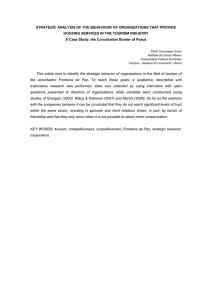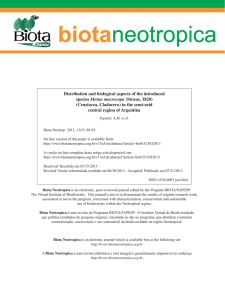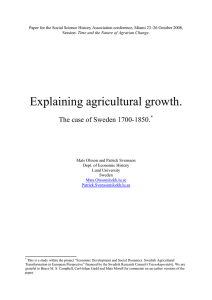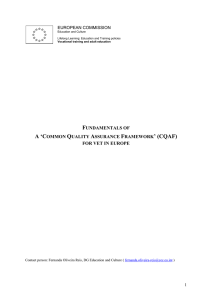Epidemiology of cattle diseases in the northeast of La Pampa
Anuncio
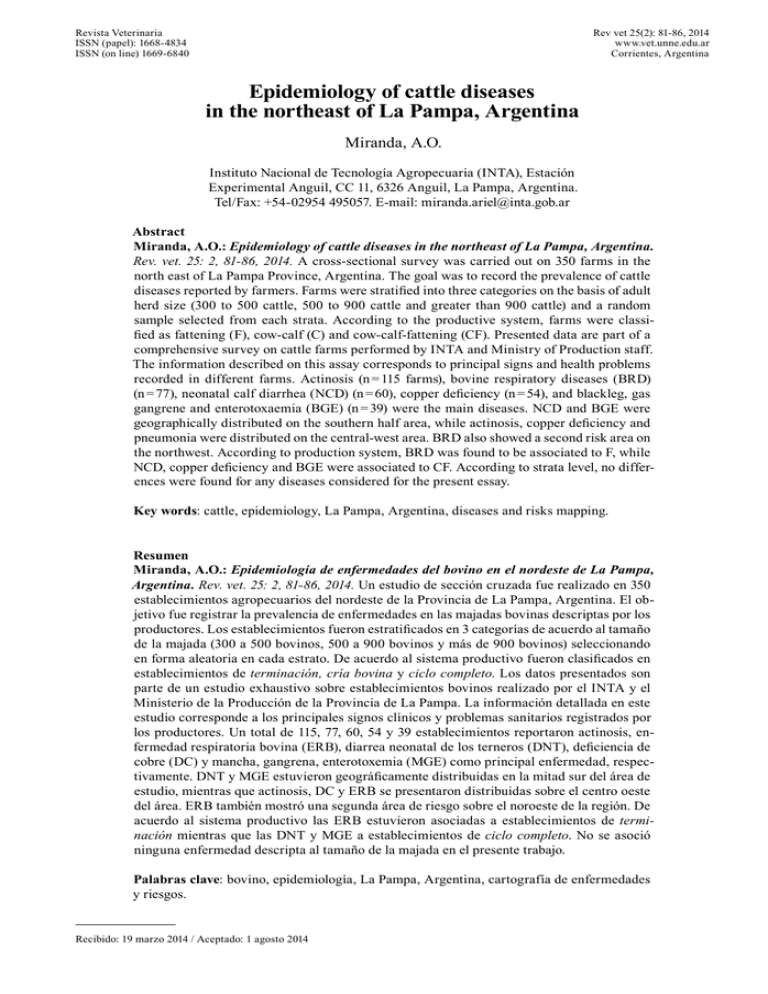
Rev vet 25(2): 81-86, 2014 www.vet.unne.edu.ar Corrientes, Argentina Revista Veterinaria ISSN (papel): 1668-4834 ISSN (on line) 1669-6840 Epidemiology of cattle diseases in the northeast of La Pampa, Argentina Miranda, A.O. Instituto Nacional de Tecnología Agropecuaria (INTA), Estación Experimental Anguil, CC 11, 6326 Anguil, La Pampa, Argentina. Tel/Fax: +54-02954 495057. E-mail: [email protected] Abstract Miranda, A.O.: Epidemiology of cattle diseases in the northeast of La Pampa, Argentina. Rev. vet. 25: 2, 81-86, 2014. A cross-sectional survey was carried out on 350 farms in the north east of La Pampa Province, Argentina. The goal was to record the prevalence of cattle diseases reported by farmers. Farms were stratified into three categories on the basis of adult herd size (300 to 500 cattle, 500 to 900 cattle and greater than 900 cattle) and a random sample selected from each strata. According to the productive system, farms were classified as fattening (F), cow-calf (C) and cow-calf-fattening (CF). Presented data are part of a comprehensive survey on cattle farms performed by INTA and Ministry of Production staff. The information described on this assay corresponds to principal signs and health problems recorded in different farms. Actinosis (n = 115 farms), bovine respiratory diseases (BRD) (n = 77), neonatal calf diarrhea (NCD) (n = 60), copper deficiency (n = 54), and blackleg, gas gangrene and enterotoxaemia (BGE) (n = 39) were the main diseases. NCD and BGE were geographically distributed on the southern half area, while actinosis, copper deficiency and pneumonia were distributed on the central-west area. BRD also showed a second risk area on the northwest. According to production system, BRD was found to be associated to F, while NCD, copper deficiency and BGE were associated to CF. According to strata level, no differences were found for any diseases considered for the present essay. Key words: cattle, epidemiology, La Pampa, Argentina, diseases and risks mapping. Resumen Miranda, A.O.: Epidemiología de enfermedades del bovino en el nordeste de La Pampa, Argentina. Rev. vet. 25: 2, 81-86, 2014. Un estudio de sección cruzada fue realizado en 350 establecimientos agropecuarios del nordeste de la Provincia de La Pampa, Argentina. El objetivo fue registrar la prevalencia de enfermedades en las majadas bovinas descriptas por los productores. Los establecimientos fueron estratificados en 3 categorías de acuerdo al tamaño de la majada (300 a 500 bovinos, 500 a 900 bovinos y más de 900 bovinos) seleccionando en forma aleatoria en cada estrato. De acuerdo al sistema productivo fueron clasificados en establecimientos de terminación, cría bovina y ciclo completo. Los datos presentados son parte de un estudio exhaustivo sobre establecimientos bovinos realizado por el INTA y el Ministerio de la Producción de la Provincia de La Pampa. La información detallada en este estudio corresponde a los principales signos clínicos y problemas sanitarios registrados por los productores. Un total de 115, 77, 60, 54 y 39 establecimientos reportaron actinosis, enfermedad respiratoria bovina (ERB), diarrea neonatal de los terneros (DNT), deficiencia de cobre (DC) y mancha, gangrena, enterotoxemia (MGE) como principal enfermedad, respectivamente. DNT y MGE estuvieron geográficamente distribuidas en la mitad sur del área de estudio, mientras que actinosis, DC y ERB se presentaron distribuidas sobre el centro oeste del área. ERB también mostró una segunda área de riesgo sobre el noroeste de la región. De acuerdo al sistema productivo las ERB estuvieron asociadas a establecimientos de terminación mientras que las DNT y MGE a establecimientos de ciclo completo. No se asoció ninguna enfermedad descripta al tamaño de la majada en el presente trabajo. Palabras clave: bovino, epidemiología, La Pampa, Argentina, cartografía de enfermedades y riesgos. Recibido: 19 marzo 2014 / Aceptado: 1 agosto 2014 82 Miranda A.O.: Prevalencia de enfermedades bovinas. Rev. vet. 25: 2, 81-86, 2014 INTRODUCTION Animal health is one of the many factors that conspire against productivity of cattle production systems. The development of health information systems, together with other aspects regarding animal production, aid in the use and interpretation of data for efficient planning and livestock policy management. There are many countries around the world where geographic information systems (GIS) 2 detect diseases, trends or productive problems as well as prevalence of pathologies in order to make rational decisions. Some states from the United States of North America 4 have developed the National Animal Health Monitoring System (NAHMS) which uses productive, economic and sanitary data gathered from cattle production. Several European countries 6, 8 are pioneers in this type of information scrutiny as well as the development of software that allows to perform analysis of risk, costbenefit relationship, and policy address. Exploratory maps help researchers to have a better understanding of the geographic distribution of diseases for defining spatial risk 1 . In Argentina and other countries of South America the implementation of databases and sanitary information systems is just beginning. These systems will help to determine cattle disease prevalence and to identify possible risk factors for better control strategies. The aim of this assay was to describe, characterize and analyze the principal cattle diseases affecting herds in the northeast of La Pampa using data gathered from a field survey. Figure 1. Map of La Pampa Province showing the location of the area of study. endoparasite, ectoparasite, horn fly, myiasis, bloat, tetany down cows and keratoconjuntivitis) was conducted. Furthermore, the survey included questions regarding clinical signs and presence or not of diseases in each farm. For the latter, not only a list of signs and symptoms but also a disease list was provided. Morbidity and mortality, category affected, and season of the year, were recorded. Finally, confirmation of diseases by means of clinical observation or laboratory tests was considered. Mapping and statistics analysis. Farm identifiers were matched with a digital map of farm boundaries Geographic area and population survey. This was and the location point of each farm was defined as the a cross sectional survey of health management practic- centroid by means of Arcgis software 9. The outcome es and prevalence diseases. The sampling frame com- geographical representation showed the risk of the area prised farms from Chapaleufú, Realicó, Rancul, Trenel, under study. However, the spatial point data is generMaracó, Conhelo, Capital, Quemú Quemú, Catriló and ally irregular as well as discretely geo-referenced in Atreucó, located in the north-east of La Pampa Prov- space and therefore requires spatial interpolation for ince, Argentina (Figure 1). For the survey, only those mapping isopleths. Geostatistical kriging method was farmers owing more than 300 bovines were considered. chosen and provided by ArcGis 9 (ESRI). On the othA total of 350 farmers were surveyed and stratified into er hand, to detect clusters, statistical spatial software three strata on the basis of herd size: small (S) (300 SaTScan (v. 7.0.3) was used, considering the presence to 500 animals), medium (M) (500 to 900) and large (1) or absence (0) of disease as qualitative and quantita(L) (more than 900). To determine the number of farms tive variable of analysis, respectively. by strata and district, a finite population sampling Risk factors inside and outside the cluster. Each method 3 was used. A confidence level of 5% was esdisease was considered as a cluster and subjected to spatablished. After defining the number of farms, random tial statistical analysis for determining high prevalence sampling from the list of farmers was used to pick the areas. It was inferred that the spatial location of farms farms to survey within each stratum. Selected farms would have conditioned the presence or absence of diswere visited by INTA and Ministry of Production staff. eases, based on productive and agro-ecological features Survey design. A cross-sectional survey of health of the region such as: productive activity (livestock, management practice with reference to spatial location agricultural and combination), productive system (CF, and productive information (stock farmer, livestock F and C) and stocking rate. For the statistical analysis hectare, principal activity) and sanitary information both descriptive and association measures techniques such as vaccinations, frequency of diseases (venereal, provided by Infostat statistic software were used 5 . MATERIAL AND METHODS Miranda A.O.: Prevalencia de enfermedades bovinas. Rev. vet. 25: 2, 81-86, 2014 83 Parasitic diseases were not considered for this assay. Actinosis: an important number of farms (n = 115) with actinosis were recorded, having low morbidity and mortality rates (Figure 3). Principal signs were jaw abscess (21.7%), swollen throat and wooden tongue (28.0%) which were easy to identify by farmers and for this reason only 52% requested veterinary diagnose. Eleven percent of farmers reported both diseases affecting animals at the same time. The maFigure 2. Percentage of morbidity and mortality of the main diseases. jor prevalence on the departments of the middle area on isopleths risk mapping is shown in Figure 3. Mapping shows two clusters, RESULTS the primary cluster had a relative risk (RR) of 2.5 (0.95; Three hundred and fifty farms conforming 378,748 p = 0.002) and the secondary cluster a RR of 3.1 (0.90; hectares (mean: 1,091 ± 1,930 ha) and having 327,993 p = 0.07). No statistical differences were found regardanimals (mean: 937 ± 1,001) were considered. A total ing risk factor analysis. of 67 (S), 112 (M) and 147 (L) farms were surveyed, beBovine respiratory diseases (BRD): cases with reing most of them a combination of cow-calf-fattening spiratory symptomatology such as colds (7.4%), coughs (n = 226; 63%). Remaining farms were either fattening (16.9%), bronchopneumonia (20.7%), fever and weak(n = 106; 33%) or cow-calf (n = 14; 4%). Median stockness (5.7%) in 77 herds, were recorded. Calves (72%) ing density was 1.12 head per hectare (range ± 0.54). and steers (17%) were affected during weaning on auAs a result of disease signs and health problems obtumn (44%) and winter (45%). Furthermore, 3.4% (F served during the survey, five main pathologies were 3.6%; CF 3.3%) of farmers reported fever, cough and described: actinosis (actinomycosis / actinobacillosis), stress after transportation. The mapping risk shows bovine respiratory diseases (BRD), neonatal calf diartwo clusters (Figure 4), the primary having a RR of 4.8 rhea (NCD), copper deficiency and black leg, gas gan(0.95; p = 0.01) and the secondary a RR of 3.18 (0.95; grene and enterotoxaemia (BGE). Figure 2 shows the p = 0.008). Regarding cluster factor risk, BRD was stamorbidity and mortality percentages of each disease. Figure 3. Isopleth risk map for actinosis. Primary and secondary clusters showing details regarding farm number, relative risk and statistic likelihood. Figure 4. Isopleth risk map of BRD. Primary and secondary clusters showing details of farm number, relative risk and statistic likelihood. 84 Miranda A.O.: Prevalencia de enfermedades bovinas. Rev. vet. 25: 2, 81-86, 2014 Figure 5. Isopleth risk map of NCD. Cluster with details of farm number, relative risk, and statistic likelihood. Figure 7. Isopleth risk map of BGE. Cluster with details of farm number, relative risk, and statistic likelihood. two areas with different epidemiological features can be seen. The north area does not have risk, while the south area shows a RR of 4.6 (0.95; p = 0.001). Production system characteristics of the southern area show a majority of CF and C productive systems in concordance with the outcome on the risk factor study (p = 0.022; OR = 1.74). No statistical differences were found between strata. Figure 6. Isopleth risk map of copper deficiency. Cluster with details of farm number, relative risk, and statistic likelihood. Copper deficiency: farmers reported copper deficiency problems (n = 54, 15%). Figure 6 shows a cluster on central east area with a RR of 3.15 (0.95; p = 0.012). On the other hand, the majority of cases (X2 4.48; p = 0.04) were present in CF farms. Livestock systems showed higher risk of copper deficiency presence (p = 0.065; OR = 1.74) than agriculture-livestock systems. Veterinary diagnostics revealed that copper deficiency affected all categories: calves (34%), cows (18%) and heifers, steers and bulls (10%). Black leg, gas gangrene and enterotoxaemia (BGE): owners reported sudden dead (n = 39, 11%), maimed animals or feeding abrupt changes as signs of black leg and gas gangrene, respectively (16.3% CF; tistically associated with fattening systems (odds ratio 4.5% F) and enterotoxaemia (3.3% CF; 2.7% F). More OR = 1.76; p = 0.051). cases of black leg or gas gangrene in CF farms (X2 9.7; p = <0.002) were observed, mainly affecting calf (87%) Neonatal calf diarrhoea (NCD): twenty five per- and baby beef (11%). The morbidity and mortality were cent (n = 60) of farmers (239) having cows and bulls 2.9% and 2.5%, respectively. In general, owners reportreported not only problems of watery faeces and colitis ed veterinary diagnose (77%). Almost the total of the in one to two week old calves but also pneumoenteritis surveyed farmers (n = 338, 98%) performed vaccination (21.8%, n = 52). Figure 5 shows the RR of NCD, where against BGE. The mean number of annual doses was Miranda A.O.: Prevalencia de enfermedades bovinas. Rev. vet. 25: 2, 81-86, 2014 85 1.47 ± 0.59, with 58%, 37% and 4.8% of farmers admin- the farmers use a second dose of the vaccine, although istering one, two and three doses per year, respectively. laboratories recommend a re-vaccination 20 to 30 days Figure 7 shows the risk of distribution of BGE with a after the first one 11 . No differences were found regardmajor presence of cases on the middle south area with ing productive system. a RR of 3.47 (0.95; p = <0.001). NCD: results showed positive association (p = 0.022; OR = 1.74) between NCD and CF and C systems but DISCUSSION no differences regarding productive strata and stockConsidering the epidemiological-productive point ing rate. White to light yellow watery faeces with bad of view, diseases showed different behaviour. Copper odour were observed on 30 days-old calves. Multiple deficiency showed high morbidity (26%) and low mor- etiologic factors (Rotavirus, Coronavirus, Escherichia tality (1%), while NCD showed low morbidity (11.03%) coli, Salmonella sp. and others) cause digestive sympbut high mortality (3.38%). This feature often puzzles toms with respiratory complications caused by Pasfarmers, who underestimate subclinical losses for those teurella sp, Parainfluenza 3, and others. This kind of diseases with low mortality. The results found in this presentation has been referred as pneumoenteritis 12 . In study regarding morbidity and mortality of diseases our assay 21.8% of the farmers referred calves to have were consistent with those found by the Regional Unit pneumoenteritis. This condition occurs during the first of Diagnostic Casuistic of INTA (National Institute of days of life and for this reason prevention is essential Agricultural Technology) (unpublished observations). by vaccination of females (cows and heifers during the last month of pregnancy) as immunity is guaranteed Actinosis: two diseases were considered under this by colostrum. Although farmers (16.5%) reported the denomination: actinomycosis (Actinomyces bovis) and use of preventive vaccines, many of them (68%) did not actinobacillosis (Actinobacillus lignieresii). Both have repeat the second dose 30 days after, despite laboratory similar clinical characteristics and treatments. Consid- specifications that recommends for pregnant heifers ering practical aspects, the exact location of the injury and unvaccinated cows two doses with an interval of will help for the final diagnose, but the identification 15 to 30 days 11. A probable reason for the latter is that of the etiologic agent by means of bacterial culture is farmers reduce management practices when cows are still the most accurate determination. Steers of 1.5 to 2 at the end of pregnancy. years old that are changing teeth are considered at risk and this characteristic agrees with the results obtained Copper deficiency: this pathology can be produced in our study, where steers (50%) and yearlings (22%) by insufficient amount of copper on the diet or excess were the main affected categories. No differences were of molybdenum or sulphates in the feeding or drinkobserved when considering productive system. Both ing water. Both cases have been reported in La Pampa etiological agents are present in the oral cavity, which Province with excess of molybdenum being the main invade deep tissues (jaw, tongue, lymph nodes of the cause 9 . Young cattle (2 or 3 months) are more suscephead, neck and thorax) after traumatic injuries (e.g. tible to copper deficiency, especially suckling calves abrasive grass) or by unknown mechanisms 7 . The oc- with cows receiving insufficient copper in their diet 10 . currence of diseases depends on individual condition; This description agrees with the results found in our this would explain the lack of association with stocking survey, where calves had the higher prevalence. Alrate and productive strata. though copper deficiency was described in all categories, suckling calf, cows and heifers were the affected BRD: under this name a set of common diseases, categories and this can be associated to CF. As regards signs and symptoms that affect young categories are to stocking rate, no differences were found and this commonly known as pneumonia. The economics could be explained because this disease is not associlosses caused by BRD (delayed growth, high mortality, ated with crowding. reduced fertility and high treatment costs) have been studied with more detail for intensive productive sysBGE: cases of mortality produced by different tems (dairy farms and feedlots) 13, 14 rather than the graz- etiologic agents (Clostridium septicum, C. chauvoei, ing or semi-intensive systems. According to our results, C. perfringens, C. sordellii and C. Novyi) were frelooses are greater for both grazing and semi-intensive quently reported by owners although an important systems. On the other hand, the productive feature of number of them vaccinated herds as prevention. This these systems -grazing feeding with low crowding- could be due to the low percentage of farmers (37%) would explain the lack of difference regarding stocking re-vaccinating livestock after 20 to 30 days after the rate. BRD is present in fattening farms where calves first application (label laboratory specifications) or lack are weaned in autumn and winter and is associated to of immunity response from commercial vaccines. BGE environmental factors, such as low temperatures and were described mainly in calves and this can be related host immunosuppressive condition. Despite being a to CF. No differences were found regarding stocking well known disease by farmers, only 28.6% (n = 100) rate, probably because most of the surveyed farms coruse vaccination to prevent it. Furthermore, only 42% of responded to semi-intensive production systems. 86 Miranda A.O.: Prevalencia de enfermedades bovinas. Rev. vet. 25: 2, 81-86, 2014 We did not find differences regarding productive strata for any disease. This is probably due to the number of heads (more than 300) of the surveyed farms. This situation probably would have changed if we would have select small-scale farmers, but this was not the objective of this epidemiological study. It is concluded that results give useful epidemiological information regarding several important diseases for the north-east of La Pampa Province and offer valuable data about risk distribution of these diseases. Results also help to make better decisions or to develop future studies to improve the competitiveness of meat production systems. Acknowledgements. The author thanks farmers and veterinarians for the unselfish collaboration. Also to the Minister of Production, Government of La Pampa Province and National Institute of Agricultural Technology (INTA) for the funds. REFERENCES 1.Berke O. 2005. Exploratory spatial relative risk mapping. Prev Vet Med 71: 173-182. 2.Bosque Sendra J. 2000. Sistemas de información geográfica, 2nd ed., Rialp, Madrid, 453 p. 3.Cochran WG. 1997. Técnicas de muestreo, CECSA, México, 513 p. 4.Curtis CR, Farrar JA. 1990. National animal health monitoring system in the United States. Prev Vet Med 8: 87-225. 5.Di Rienzo JA, Casanoves F, Balzarini MG, Gonzalez L, Tablada M, Robledo CW. 2010. InfoStat V. 2010. Grupo InfoStat, FCA, Univ. Nac. Córdoba, Argentina. 6.Frankena K, Noordhuizen JP, Willeberg P, van Voorhuysen PF, Goelema JO. 1990. Episcope, computer programs in veterinary epidemiology. Vet Rec 9: 573-576. 7. Jones TC, Hunt RD, King NW. 1997. Veterinary Pathology, 6th ed., Williams & Wilkins, Baltimore, 1392 p. 8.Morris RS, Sanson RL, McKenzie JS, Marsh WE. 1993. Decision support systems in animal health. Proceedings of the Society for Veterinary Epidemiology and Preventive Medicine, Exeter (UK): 188-199. 9. Pechin G, Cseh S, Corbellini C, Idiart J, Moralejo R, Visconti M, Drake M, Yarrar M. 1995. Estudio de la deficiencia mineral en bovinos de carne en el Departamento Maracó, La Pampa, Argentina. Rev Arg Prod Anim 15: 492-494. 10.Radostits OM, Gay CC, Blood DC, Hinchcliff KW. 2002. Medicina Veterinaria, tratado de las enfermedades del ganado bovino, ovino, porcino, caprino y equino, 9º ed., McGraw-Hill, Barcelona, p. 1766-1784. 11.Suárez VH et al. (12 autores). 2006. Características del manejo sanitario en el este de la Provincia de La Pampa, Argentina. Boletín Divulg Técn INTA Anguil (La Pampa, Argentina), 90: 111. 12.Suárez VH et al. (14 autores). 2008. Prevalencia de patologías e incidencia de la sanidad en los sistemas bovinos en el este de la Provincia de La Pampa, Argentina. Vet Arg 25: 258-280. 13.Snowder GD, Van Vleck LD, Cundiff LV, Bennett GL. 2006. Bovine respiratory disease in feedlot cattle: Environmental, genetic, and economic factors. J Anim Sci 84: 1999-2008. 14.Van der Fels-Klerx HJ, Sorensen JT, Jalvingh AW, Huirne RB. 2001. An economic model to calculate farmspecific losses due to bovine respiratory disease in dairy heifers. Prev Vet Med 51: 75-94. Dr. Juan José Brem Luego de doce años de desempeñarse como Administrador (ad honorem) de “Revista Veterinaria” se produjo el alejamiento del Dr. Juan José Brem. Quienes integramos el cuerpo editorial de la publicación oficial de la Facultad de Ciencias Veterinarias de la UNNE le hacemos llegar nuestro reconocimiento por la eficiente tarea realizada durante el lapso 2003-2014.


